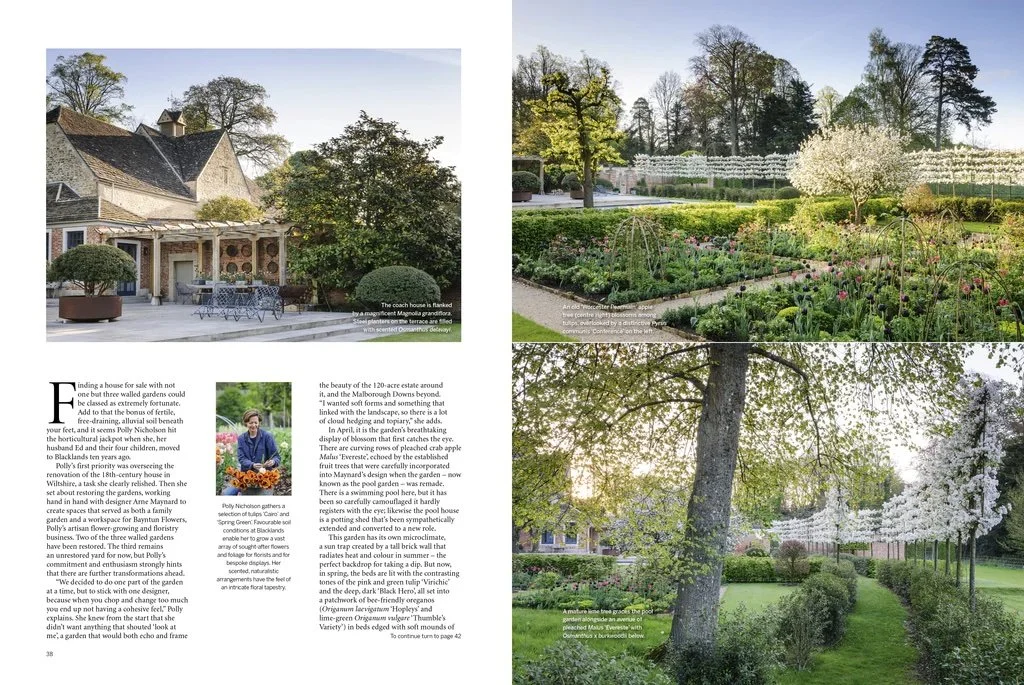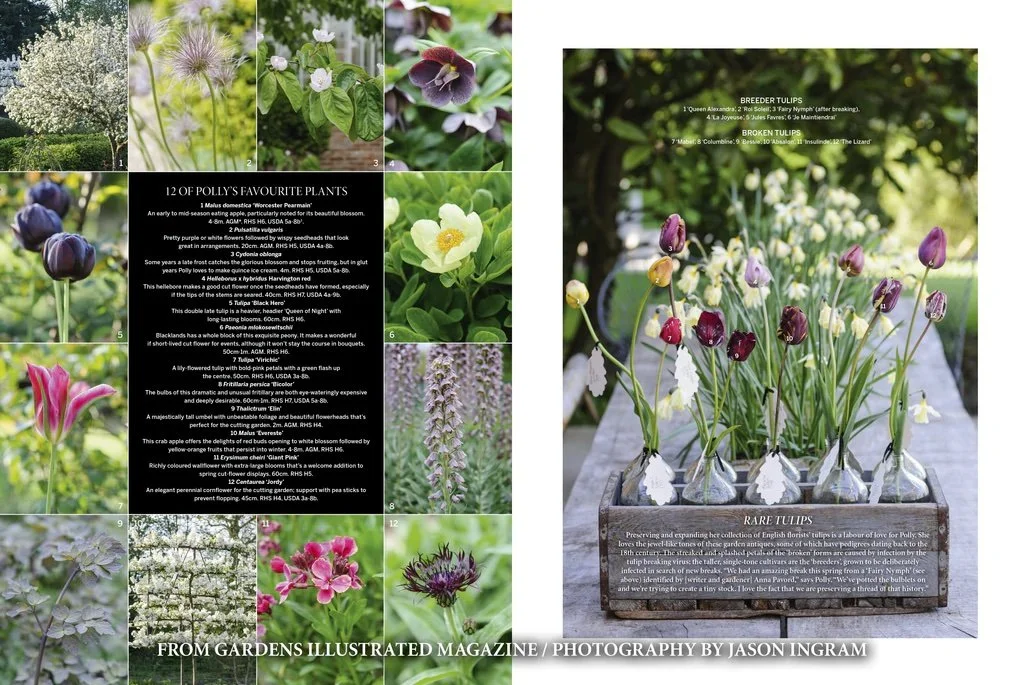Gardens Illustrated | A Modern Grower
WORDS JANE PERRONE | PHOTOGRAPHS JASON INGRAM
Around Blackland House in Wiltshire, Arne Maynard has designed a series of walled gardens filled with plants of the highest pedigree.
IN BRIEF
Name Blackland House.
What A Georgian house and walled gardens set in a 120-acre estate at the foot of the Marlborough Downs.
Where Calne, Wiltshire.
Size Four and a half acres.
Soil Free-draining, alluvial soil.
Climate Temperate.
Hardiness zone USDA 8.
In the pool garden , the repurposed potting shed, now a pool house, overlooks beds of tulips 'Virichic' and 'Black Hero' with mounds of Origanum laevigatum 'Hopleys' and O. vulgare 'Thumble's Variety'. The outer edges of the grid of beds are lined with Daphne x transatlantica Eternal Fragrance (=‘Blafra’) and the inner edges with Teucrium x lucidrys.
CAPTIONS CLOCKWISE FROM TOP LEFT.
The coach house is flanked by a magnificent Magnolia grandiflora. Steel planters on the terrace are filled with scented Osmanthus delavayi.
An old ‘Worcester Pearmain’ apple tree (centre right) blossoms among tulips, overlooked by a distinctive Pyrus communis ‘Conference’ on the left.A mature lime tree graces the pool garden alongside an avenue of pleached Malus ‘Evereste’ with Osmanthus x burkwoodii below.
Polly Nicholson gathers a selection of tulips ‘Cairo’ and ‘Spring Green’. Favourable soil conditions at Blacklands enable her to grow a vast array of sought-after flowers and foliage for florists and for bespoke displays. Her scented, naturalistic arrangements have the feel of an intricate floral tapestry.
Finding a house for sale with not the beauty of the 120-acre estate around one but three walled gardens could be classed as extremely fortunate. Add to that the bonus of fertile, free-draining, alluvial soil beneath your feet, and it seems Polly Nicholson hit the horticultural jackpot when she, her husband Ed and their four children, moved to Blacklands ten years ago.
Polly’s first priority was overseeing the renovation of the 18th-century house in Wiltshire, a task she clearly relished. Then she set about restoring the gardens, working hand in hand with designer Arne Maynard to create spaces that served as both a family garden and a workspace for Bayntun Flowers, Polly’s artisan flower-growing and floristry business. Two of the three walled gardens have been restored. The third remains an unrestored yard for now, but Polly’s commitment and enthusiasm strongly hints that there are further transformations ahead.
“We decided to do one part of the garden at a time, but to stick with one designer, because when you chop and change too much you end up not having a cohesive feel,” Polly explains. She knew from the start that she didn’t want anything that shouted ‘look at me’, a garden that would both echo and frame the beauty of the 120-acre estate around it, and the Malborough Downs beyond. “I wanted soft forms and something that linked with the landscape, so there is a lot of cloud hedging and topiary,” she adds.
In April, it is the garden’s breathtaking display of blossom that first catches the eye. There are curving rows of pleached crab apple Malus ‘Evereste’, echoed by the established fruit trees that were carefully incorporated into Maynard’s design when the garden – now known as the pool garden – was remade. There is a swimming pool here, but it has been so carefully camouflaged it hardly registers with the eye; likewise the pool house is a potting shed that’s been sympathetically extended and converted to a new role.
This garden has its own microclimate, a sun trap created by a tall brick wall that radiates heat and colour in summer – the perfect backdrop for taking a dip. But now, in spring, the beds are lit with the contrasting tones of the pink and green tulip ‘Virichic’ and the deep, dark ‘Black Hero’, all set into a patchwork of bee-friendly oreganos (Origanum laevigatum ‘Hopleys’ and lime-green Origanum vulgare ‘Thumble’s Variety’) in beds edged with soft mounds of Daphne x transatlantica Eternal Fragrance (= ‘Blafra’) and Teucrium x lucidrys.
12 OF POLLY’S FAVOURITE PLANTS
1 Malus domestica ‘Worcester Pearmain’
An early to mid-season eating apple, particularly noted for its beautiful blossom.
4-8m. AGM*. RHS H6, USDA 5a-8b†.
2 Pulsatilla vulgaris
Pretty purple or white flowers followed by wispy seedheads that look
great in arrangements. 20cm. AGM. RHS H5, USDA 4a-8b.
3 Cydonia oblonga
Some years a late frost catches the glorious blossom and stops fruiting, but in glut
years Polly loves to make quince ice cream. 4m. RHS H5, USDA 5a-8b.
4 Helleborus x hybridus Harvington red
This hellebore makes a good cut flower once the seedheads have formed, especially if the tips of the stems are seared. 40cm. RHS H7, USDA 4a-9b.
5 Tulipa ‘Black Hero’
This double late tulip is a heavier, headier ‘Queen of Night’ with long-lasting blooms. 60cm. RHS H6.
6 Paeonia mlokosewitschii
Blacklands has a whole block of this exquisite peony. It makes a wonderful
if short-lived cut flower for events, although it won’t stay the course in bouquets.
50cm-1m. AGM. RHS H6.
7 Tulipa ‘Virichic’
A lily-flowered tulip with bold-pink petals with a green flash up the centre. 50cm. RHS H6, USDA 3a-8b.
8 Fritillaria persica ‘Bicolor’
The bulbs of this dramatic and unusual fritillary are both eye-wateringly expensive
and deeply desirable. 60cm-1m. RHS H7, USDA 5a-8b.
9 Thalictrum ‘Elin’
A majestically tall umbel with unbeatable foliage and beautiful flowerheads that’s
perfect for the cutting garden. 2m. AGM. RHS H4.
10 Malus ‘Evereste’
This crab apple offers the delights of red buds opening to white blossom followed by yellow-orange fruits that persist into winter. 4-8m. AGM. RHS H6.
11 Erysimum cheiri ‘Giant Pink’
Richly coloured wallflower with extra-large blooms that’s a welcome addition to
spring cut-flower displays. 60cm. RHS H5.
12 Centaurea ‘Jordy’
An elegant perennial cornflower for the cutting garden; support with pea sticks to
prevent flopping. 45cm. RHS H4, USDA 3a-8b.
BREEDER TULIPS
1 ‘Queen Alexandra’, 2 ‘Roi Soleil’, 3 ‘Fairy Nymph’ (after breaking),
4 ‘La Joyeuse’, 5 ‘Jules Favres’, 6 ‘Je Maintiendrai’
BROKEN TULIPS
7 ‘Mabel’, 8 ‘Columbine’, 9 ‘Bessie’, 10 ‘Absalon’, 11 ‘Insulinde’, 12 ‘The Lizard’
RARE TULIPS
Preserving and expanding her collection of English florists’ tulips is a labour of love for Polly. She loves the jewel-like tones of these garden antiques, some of which have pedigrees dating back to the 18th century. The streaked and splashed petals of the ‘broken’ forms are caused by infection by the tulip breaking virus; the taller, single-tone cultivars are the ‘breeders’, grown to be deliberately infected in search of new breaks. “We had an amazing break this spring from a ‘Fairy Nymph’ (see
above) identified by [writer and gardener] Anna Pavord,” says Polly. “We’ve potted the bulblets on and we’re trying to create a tiny stock. I love the fact that we are preserving a thread of that history.”
CAPTIONS CLOCKWISE FROM TOP LEFT.
The greenhouse is the centrepiece of the ornamental walled garden. Box topiary is underplanted with Pulsatilla vulgaris, Origanum and Euphorbia epithymoides, while the central rill holds irises ‘Delta Butterfly’, ‘Merebrook Purpla’ and ‘Black Gamecock’.
A view of the walled garden looking towards the coach house. The paths are made of hoggin mixed with local pea gravel.
Towards the neighbouring church, pollarded limes, with cloud-pruned yew behind and balls of Osmanthus x burkwoodii in front, are planted into wildflower turf yielding a succession of bulbs.
The greenhouse, described by Polly as “a wonderful light space that keeps the garden anchored”, is used for propagating plants and growing early spring bulbs for the cut-flower business including the Dutch Iris ‘Red Ember’, I. ‘Eye of Tiger’ and Iris tuberos.
There’s evidence of Polly’s clever eye for reusing and recycling unexpected items and materials throughout the garden, from the grid of garden riddles on the wall and the roof tiles redeployed to line beds, to the sheep’s knuckles used to make a decorative flooring for the twig house, which provides shelter and shade. Working with a Chelsea award-winning garden designer allowed for another form of recycling. A characterful and productive ‘Conference’ pear tree graces the pool garden, while in the ornamental walled garden next door, delightfully mismatched box topiary shapes stand sentinel either side of the symmetrical water feature: all these specimens came from Maynard’s 2012 Chelsea show garden for Laurent-Perrier. The neat structure of the box – kept in rude health by estate manager and topiary specialist Ed Heard – is balanced by the haze of planting in the gravel below, featuring Pulsatilla seedheads, oreganos and cushion spurge (Euphorbia epithymoides), which Polly describes as “just the right level of invasive in this context”.
Once a tennis court, the walled garden is productive and ornamental in equal measure. The Foster & Pearson greenhouse is its working heart. One side is for propagating flowers and raising early spring bulbs for the floristry business, the other for growing tomatoes, chillies and flat peaches for the house. Although a separate flower field provides space for Polly’s cut-flower-growing business, she also picks from her own gardens. Bayntun Flowers supplies flowers wholesale to select florists in London and in Wiltshire, as well as creating bespoke displays for events. Polly is constantly experimenting with rare, new and unusual flowers and bulbs, assisted by her head gardener and brilliant plantswoman Hannah Gardner. “The people I am supplying don’t necessarily want bulk, they just want something different,” she concludes. “And I can do different because I’ve got amazing soil, the expertise and this wonderful place to do it in.”
USEFUL INFORMATION
The garden is not generally open to the public aside from occasional open days for charity. Bayntun Flowers also runs seasonal events. bayntunflowers.co.uk




